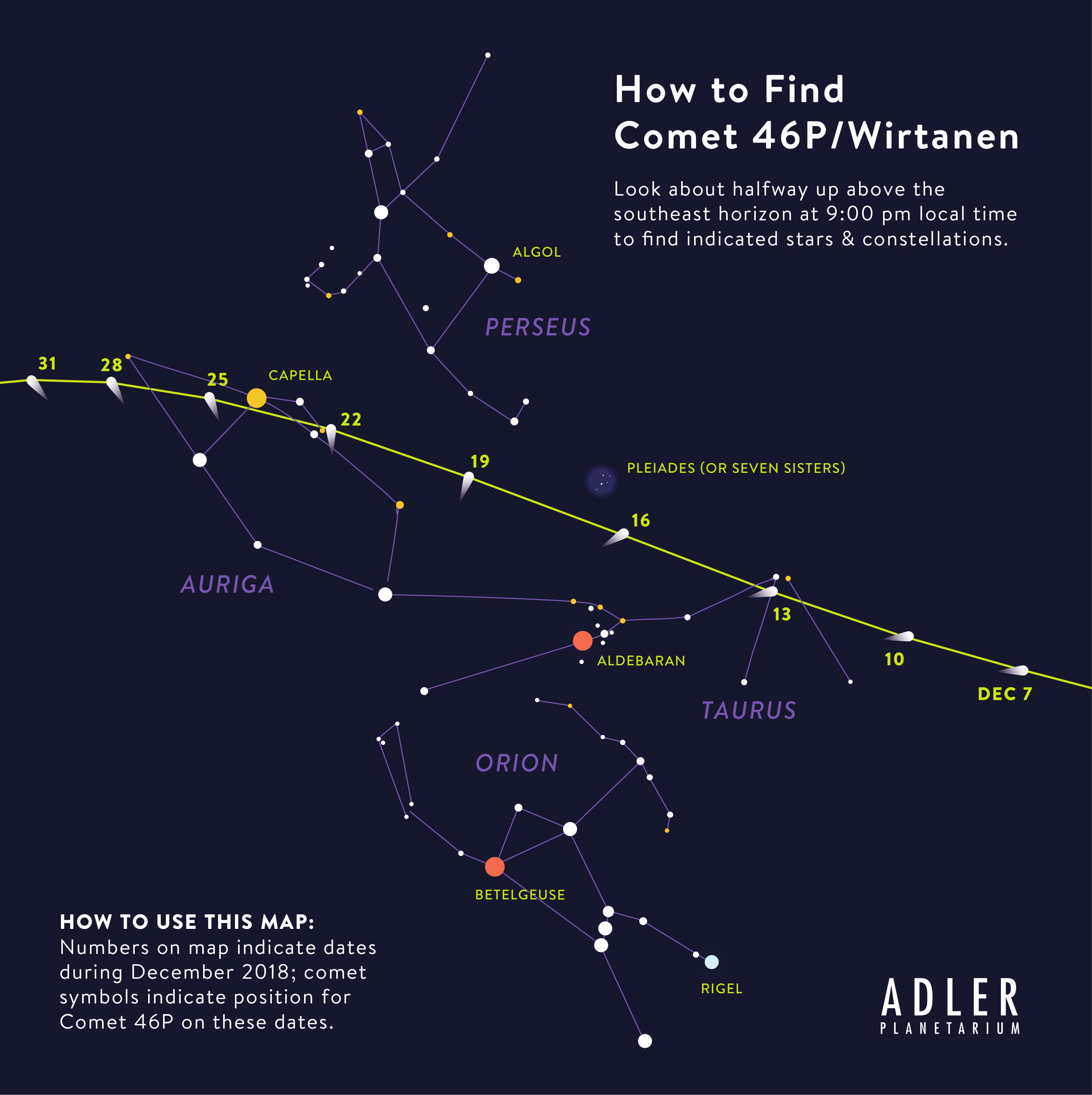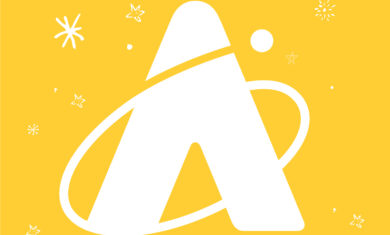A Holiday Comet?

Have you ever seen a comet in the night sky? I suspect most of the people reading this haven’t. It’s not that there aren’t a lot of comets in the Solar System—more than 5,000 have been discovered so far and several dozen can be spotted using very large telescopes each year—but because most comets are extremely dim and only a handful have brightened enough to overcome our light polluted skies, this makes seeing a comet one of the more rare experiences in astronomy.
This December, Comet 46P/Wirtanen is getting a bit of attention because as of early December, it has become bright enough to be seen using binoculars under dark skies far from city lights. Will it get brighter? Only time will tell.
What, exactly, is a comet? The name “comet” comes from the Latin word “coma,” which means “hair,” the name given because these objects looked very fuzzy & hairy in the sky. A comet is a chunk of mostly various ices, dust, and rock. Comets generally orbit the Sun, some with orbits of just a few years and some with orbits that are much longer than that, like Comet Halley’s 76 year orbit around the Sun, Comet Hale-Bopp’s ~2,500 year orbit, and Comet Hyakutake’s ~70,000 year orbit. Some might visit our neighborhood in the Solar System just once before heading off into the deep-freeze of space. The head, or the ice chunk itself, of a comet can range in size from less than a mile wide to a few tens of miles wide. As a comet approaches the Sun, its ices start to heat up, causing the head of the comet to let loose some of this material. The material streaming away from the head forms the comet’s tail. Comet tails can stretch for millions or even tens of millions of miles, and a comet may have more than one tail.
Comet 46P/Wirtanen (pronounced vir-TUN-nen) orbits our Sun in just over 5 years, and it was discovered by American astronomer Carl Wirtanen in 1948. In December 2018, Comet Wirtanen is passing particularly to Earth, about 7 million miles away, which places this comet among the top 10 closest comets to pass by Earth since 1966. This close distance combined with its predicted brightness has caused amateur astronomers to get a little excited about the possibility of seeing a decently-bright comet.
Comet 46P’s orbit is well known, but its brightness is difficult to predict. Several comets in the past few decades have disappointed us with a brightness—or dimness, actually—that is less than impressive. We don’t know for sure what a comet is going to do when the Sun interacts with it. One extreme example was 2012’s Comet ISON, named for the International Scientific Optical Network (ISON, sometimes pronounced “EYE-sahn”) in Russia that discovered it. Comet ISON passed just over 500,000 miles from the Sun and was going to swing around to be seen in our December 2012 evening skies—and maybe even bright enough for us to spot it from cities! We let ourselves get a bit excited, and we made preliminary plans at the Adler Planetarium to try to spot it after it rounded the Sun, but excitement was soon replaced by utter disappointment as Comet ISON disintegrated after passing close to the Sun. To paraphrase Monty Python: Comet ISON is no more. Comet ISON has ceased to be. Comet ISON is an ex-comet.
Two comets that I mentioned previously did, however, live up to the brightness hype: Comet Hyakutake, named for Yuji Hyakutake (pronounced HYAH-ku-TAH-kay), a Japanese amateur astronomer, and Comet Hale-Bopp, named for Alan Hale and Thomas Bopp, two people who separately discovered it on the same night. Comet Hale-Bopp was discovered in 1995, about two years before it was going to swing past the Earth and Sun. This comet started getting active when it was out near Jupiter’s orbit, which is rare for comets. Yuji Hyakutake discovered his namesake comet in 1996 just a couple months before it was going to pass closest to the Earth and Sun. Comet Hyakutake was dim at first but brightened rapidly, and by the end of March, we could see it from the Adler Planetarium without telescopes or binoculars even under Chicago’s light polluted skies. And just a year later, Comet Hale-Bopp swung by. Both comets were absolutely spectacular.
Below are two pictures that I took of Comet Hyakutake, both from the western suburbs of Chicago. The third picture is of Comet Hale-Bopp, as seen from in front of the Adler Planetarium.



If you missed these comets or if you are too young to remember them, next time you chat with an amateur astronomer who was scanning the skies around that time, ask him or her to tell you about those comets. She or he may gaze wistfully into the distance, with a look that might say, “Will we ever see a comet like that again?”
Will Comet 46P/Wirtanen be bright enough to be seen with just our eyes or could we spot it under light polluted skies? More than likely, light pollution might win out this time, but it won’t stop folks from trying to see it. That’s what makes astronomy fun… getting out and trying to find something yourself!. Behind the scenes at the Adler, we’ve been keeping an eye on reports about this comet for about two2 months now, trying to figure out if it is going to be worth braving December’s cold lakefront weather to attempt to show it to you. Images shared by the astronomy community show a beautiful green comet, but these are very long-exposure images, not how the comet truly appears to our unaided eyes. Recent reports we’ve received from local amateur astronomers suggest that the comet is currently visible under very dark, clear, dry skies, but when you add in a little light pollution or haze, the comet isn’t so easily spotted.
Want to try to find Comet 46P/Wirtanen? Go out where it is VERY dark—far from city lights—and use the map below to pinpoint the comet’s position during December 2018. Use a small telescope or binoculars and look for a faint fuzzy blob. We’ll keep an eye on it here at the Adler, and if it is bright enough, and if the weather cooperates, maybe we’ll be able to get our telescopes out to show it to you. Keep an eye on our social media channels, just in case. And if Comet 46P isn’t the next great comet, then we’ll just sit back, gaze wistfully off into the distance, and think about the time when two beautiful comets graced our Chicago skies.







